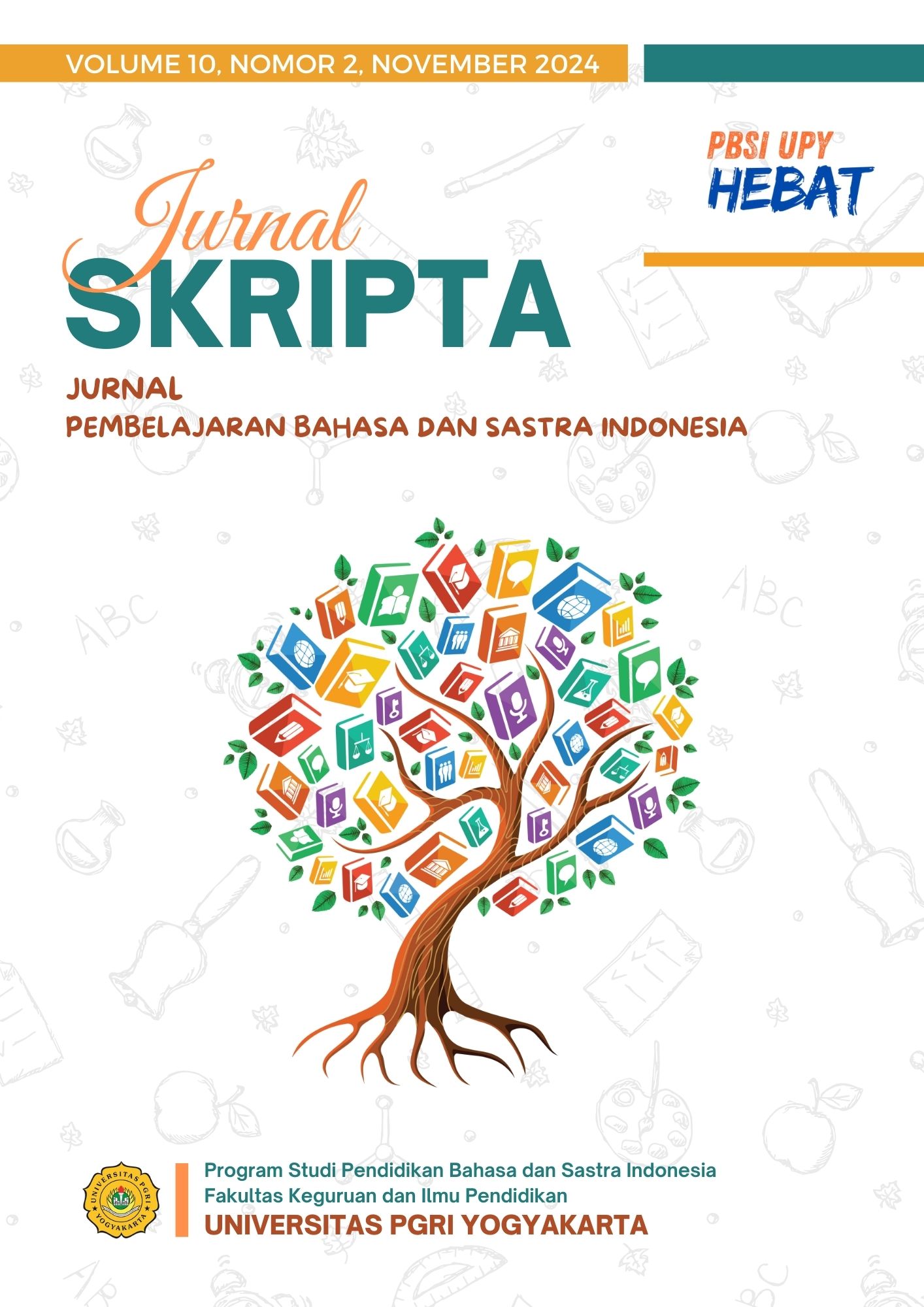PSYCHICAL CONFRONTATION OF THE MAIN CHARACTER IN THE FILM PULANG DIRECTED BY AZHAR KINOL LUBIS: LITERATURE PSYCHOLOGICAL ANALYSIS
DOI:
https://doi.org/10.31316/skripta.v10i2.7692Keywords:
Literary Psychology, Psychological Confrontation, Pulang FilmAbstract
This research aims to determine the psychological confrontation of the main character in the film Pulang, directed by Azhar Kinoi Lubis, including: 1) What is the building structure in the film Pulang, directed by Azhar Kinoi Lubis? 2) What is the psychic coherence of the main character in the film Pulang, directed by Azhar Kinoi Lubis? This research uses a qualitative descriptive method, because the data obtained and the analysis used in this research are qualitative. Data collection techniques in this research used documentation, observation and previous research techniques. The data analysis techniques used in this research are listening, grouping, analyzing and drawing conclusions. The results of the research show that the analysis of the psychological confrontation of the main character in the film Pulang, directed by Azhar Kinoi Lubis, is: 1) the character of the main character in the film Pulang 2) the psychological confrontation of the main character in the film Pulang which includes the id, ego and super ego aspects of each character.
References
Ahmadi, A. (2015). Psikologi sastra. Penerbit Unesa University Press.
Alfathoni, M. A. M., & Manesah, D. (2020). Pengantar Teori Film. Deepublish.
Arsyad, L., Akhmad, E., & Habibie, A. (2021). Membekali anak usia dini dengan pendidikan karakter: Analisis cerita film animasi Upin dan Ipin. WASKITA: Jurnal Pendidikan Nilai dan Pembangunan Karakter, 5(1), 59-71.
Astuti, R. E., Mujiyanto, Y., & Rohmadi, M. (2017). Analisis Psikologi Sastra dan Nilai Pendidikan dalam Novel Entrok Karya Okky Madasari serta Relevansinya sebagai Materi Pembelajaran Sastra di Sekolah Menengah Atas. BASASTRA, 4(2), 175-187.
Creswell, J. W. (2009). Research Design. In V. Knight (Ed.), Paper Knowledge. Toward a Media History of Documents (3rd ed.). Sage Publications Ltd.
Dea Meylla Savella Dewi, Dkk. (2022). Konflik Batin Tokoh Utama Perempuan Film “Ku Kira Kau Rumah” Karya Umay Shahab. Vol 1, 507-516.
Farid, F. (2018). Dahsyatnya Akibat Menonton FIlm serta Penawarnya. Mitra Buku.
Harahap, Y. F. (2016). Pengaruh menonton film edukasi terhadap konsep diri remaja di Panti Asuhan Hafidzil Yatamu Kelurahan Sabungan Jae Kecamatan Padangsidimpuan Hutaimbaru (Doctoral dissertation, IAIN Padangsidimpuan).
Hartono, L. (2015). Teknik humor dalam film Warkop DKI. Jurnal E-komunikasi, 3(1).
Istikawati, Rindi Aswi Pertiwi, Dkk. (2024). Konflik Batin Dalam Film Ngenest Karya Ernest Prakarsa: Kajian Psikoanalisis Sigmund Freud. 13(1), 55-67.
Merriam, S. B. (2013). Qualitative Research (2nd ed.). Jossey Bass.
Miles, M. B., & Huberman, A. M. (2014). Qualitative data analysis. Sage Publications Ltd.
Minderop, A. (2010). Psikologi sastra: karya, metode, teori, dan contoh kasus. Yayasan Pustaka Obor Indonesia.
Mutmainna, M., Mursalim, M., & Sari, N. A. (2021). Kepribadian Tokoh Utama dalam Novel Posesif Karya Lucia Priandarini: Kajian Psikologi Sastra. Ilmu Budaya: Jurnal Bahasa, Sastra, Seni, dan Budaya, 5(2), 262-272.
Noviyanti, P. B., & Dermawan, R. N. (2018). Konflik Batin Tokoh Utana Pada Novel Lelaki Harimau Karya Eka Kurniawan: Pendekatan Psikologi Sastra. Caraka: Jurnal Ilmu Kebahasaan, Kesastraan, dan Pembelajarannya, 5(1), 174-196.
Panjaitan, R. G. P., Wahyuni, E. S., & Mega, M. (2019). Film dokumenter sebagai media pembelajaran submateri zat aditif. JPBIO (Jurnal Pendidikan Biologi), 4(2), 52-59.
Pradita, L. E., Sumarwati, S., & Suhita, R. (2012). Konflik batin tokoh utama dalam film Sang Pencerah karya Hanung Bramantyo. Basastra, 1(1), 092-104.
Putri, R., Murtono, M., & Ulya, H. (2021). Nilai-nilai pendidikan karakter film animasi Upin dan Ipin. Jurnal Educatio FKIP UNMA, 7(3), 1253-1263.
Radhiyatullah, A., Indriani, N., & Ginting, M. H. S. (2015). Pengaruh Berat Pati Dan Volume Plasticizer Gliserol Terhadap Karakteristik Film Bioplastik Pati Kentang. Jurnal Teknik Kimia USU, 4(3), 35-39.
Razzaq, A. A., Sutejo, S., & Setiawan, H. (2022). Konflik Batin Tokoh Mustafa dalam Novel Tempat Paling Sunyi Karya Arafat Nur. Jurnal Bahasa dan Sastra, 9(1).
Rikarno, R. (2015). Film dokumenter sebagai sumber belajar siswa. Ekspresi Seni: Jurnal Ilmu Pengetahuan dan Karya Seni, 17(1), 129-149.
Siswanto, W., & Roekhan, M. P. (2022). Psikologi Sastra. Media Nusa Creative (MNC Publishing).
Soeharsono, E. A. (2022). PERANCANGAN KAMPANYE KOMUNIKASI VISUAL UNTUK REMAJA MENGENAI MENONTON FILM DI PLATFORM LEGAL (Doctoral dissertation, Unika Soegijapranata Semarang).
Sugiyono (2022). Metode Penelitian Kuantitatif, Kualitatif, dan R&D. Bandung: Alfabeta.
Tara, S. N. A., Rohmadi, M., & Saddhono, K. (2019). Konflik batin tokoh utama dalam novel karya Ruwi Meita tinjauan psikologi sastra dan relevansinya sebagai bahan ajar sastra indonesia di SMA. Basastra: Jurnal Bahasa, Sastra, dan Pengajarannya, 7(1), 103-112.
Wandira, J. C., Hudiyono, Y., & Rokhmansyah, A. (2019). Kepribadian Tokoh Aminah Dalam Novel Derita Aminah Karya Nurul Fithrati: Kajian Psikologi Sastra. Jurnal Ilmu Budaya Vol, 3(4), 413-419.
Downloads
Published
How to Cite
License
Copyright (c) 2024 Yanuar Bagas Arwansyah, Ristiana Sukma Arianti, Tomi Wahyu Septarianto

This work is licensed under a Creative Commons Attribution-NonCommercial 4.0 International License.
- Authors retain copyright and grant the journal right of first publication with the work simultaneously licensed under a Creative Commons Attribution License that allows others to share the work with an acknowledgment of the work’s authorship and initial publication in this journal.
- Authors are able to enter into separate, additional contractual arrangements for the non-exclusive distribution of the journal’s published version of the work (e.g., post it to an institutional repository or publish it in a book), with an acknowledgment of its initial publication in this journal.
- Authors are permitted and encouraged to post their work online (e.g., in institutional repositories or on their website) prior to and during the submission process, as it can lead to productive exchanges, as well as earlier and greater citation of published work.





